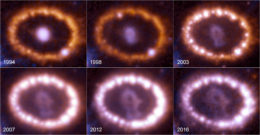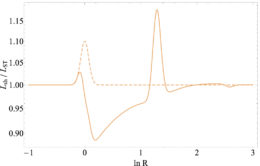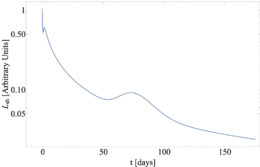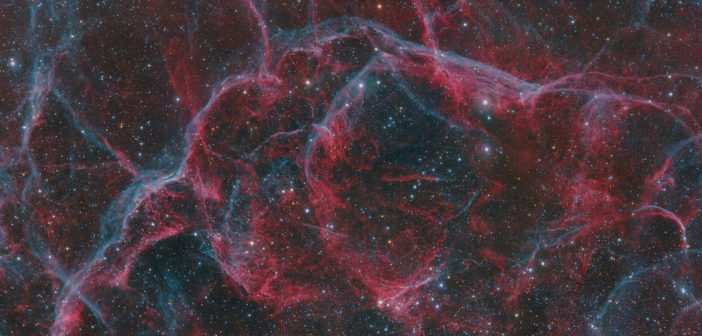Some supernovae unexpectedly increase in brightness in ways that our current models can’t explain. Can a new model that combines shock waves and sound waves make sense of this mystery?
Late to the Party

This time series of Hubble images shows the expansion of supernova remnant SN 1987A. As shock waves interacted with the ambient gas, the supernova remnant brightened dramatically. [NASA, ESA and R. Kirshner (Harvard-Smithsonian Center for Astrophysics and Gordon and Betty Moore Foundation) and P. Challis (Harvard-Smithsonian Center for Astrophysics)]
New work by Eric Coughlin (Syracuse University) and Jonathan Zrake (Clemson University) suggests that delayed brightening might not always be evidence for a new interaction with circumstellar material — but rather, an echo of a previous perturbation.
A Sound Solution
Coughlin and Zrake used linear perturbation theory — a way to mathematically describe the properties of a system in terms of a slowly varying background and a small perturbation in that background — to explore the scenario in which a supernova shock wave expanding into circumstellar material encounters an especially dense region of gas.

The shock luminosity relative to the luminosity obtained when there is no density enhancement present (solid line) is plotted as a function of the shock’s position. The scaled density is shown by the dotted line. [Adapted from Coughlin & Zrake 2022]
So far, this is just a typical interaction between a shock wave and circumstellar material. Here’s where things change: the new model explored by Coughlin and Zrake incorporates a second wave — a slower-moving sound wave — which is launched by the initial collision between the shock wave and the denser circumstellar material. As the shock wave slows down, the sound wave catches up to it and hits it from behind. In the authors’ new framework, it’s the interaction between the initial shock wave and the secondary sound wave that causes the second brightening of the supernova — not a change in the density of the surrounding material. And since no additional material is being swept up and ionized, no new emission lines are produced.
Explaining Outliers

The shock luminosity as a function of time for the density enhancement introduced in the previous figure. The increase in luminosity around 75 days agrees qualitatively with the observations of SN 2019tsf. [Adapted from Coughlin & Zrake 2022]
The authors note that there’s much more to explore, since real supernovae expanding into circumstellar gas are far more complex than the framework introduced in this article. Hopefully, future work will help us understand the wide variety of supernova behaviors seen so far!
Citation
“A Physical Model of Delayed Rebrightenings in Shock-interacting Supernovae without Narrow-line Emission,” Eric R. Coughlin and Jonathan Zrake 2022 ApJ 927 148. doi:10.3847/1538-4357/ac4033
